Additional information
| Dimensions | 8.5 × 11 in |
|---|---|
| Cover | Paperback |
| Dimensions (W) | 8 1/2" |
| Dimensions (H) | 11" |
| Page Count | 58 |
| Publisher | Edge Enterprises, Inc. |
| Year Printed | 2002 |
$15.00
| Dimensions | 8.5 × 11 in |
|---|---|
| Cover | Paperback |
| Dimensions (W) | 8 1/2" |
| Dimensions (H) | 11" |
| Page Count | 58 |
| Publisher | Edge Enterprises, Inc. |
| Year Printed | 2002 |
Overview
The Organizing Together Program is used to teach students how to organize their notebooks, desks, and lockers. The research was conducted in four, fourth-grade general education classes. Two classes were randomly selected for the experimental condition; the other two were selected for the comparison condition. A total of 124 students participated, with 64 in the experimental classes and 60 in the comparison classes. Students ranged in age from 7 to 10 years. Twenty-seven percent were students with exceptionalities; 32% were representatives of minority populations. The teachers of the experimental classes taught their students the Organizing Together Program. The teachers of the comparison classes did not use this program.
Results
Data were also gathered on organization of the students’ desks, notebooks, and backpacks. Observers determined the percentage of items completed correctly on a checklist related to each item inspected. Figures 1, 2, 3, and 4 show the mean percentage of items correctly organized in the students’ desks, notebooks, backpacks, and calendars, respectively. Experimental students organized more items in their desks, notebooks, backpacks, and calendars than the comparison students. The ANCOVAs (using the pretest scores as the covariate) showed that the adjusted mean scores gathered during observations after the experimental classes participated in Organizing Together instruction were significantly different between the experimental and comparison students for desk organization [F (1, 123) = 49.286, p < .000, η2 = .280], notebook organization [F (1, 112) = 833.300, p < .000, η2 = .887], backpack organization [ F (1, 117) = 12.814, p < .001, η2 = .109], and calendar recordings [F (1, 108) = 22.173, p < .0001, η2 = .389]. (These η2s represent large and medium effect sizes.) The adjusted mean scores for the experimental group were significantly larger than the adjusted mean scores for the comparison group in all cases.
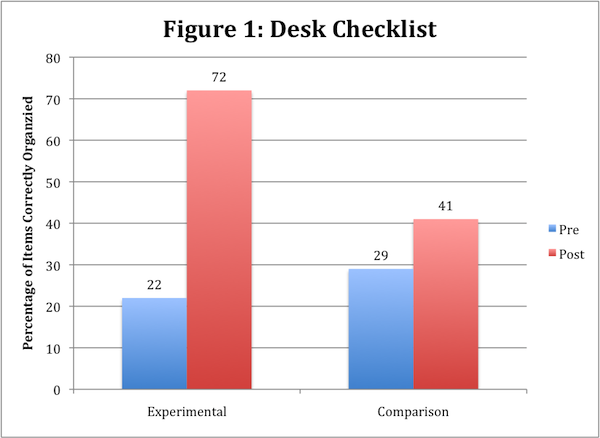
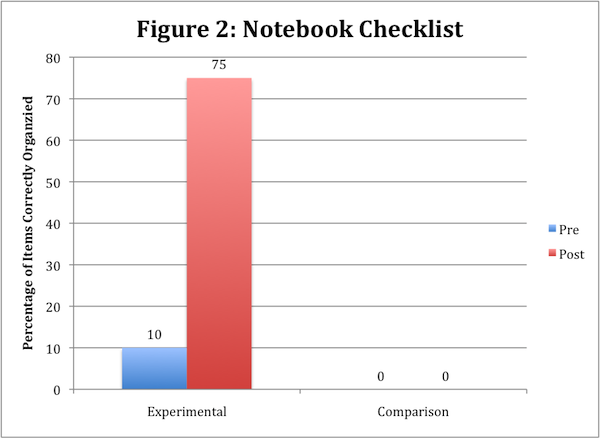
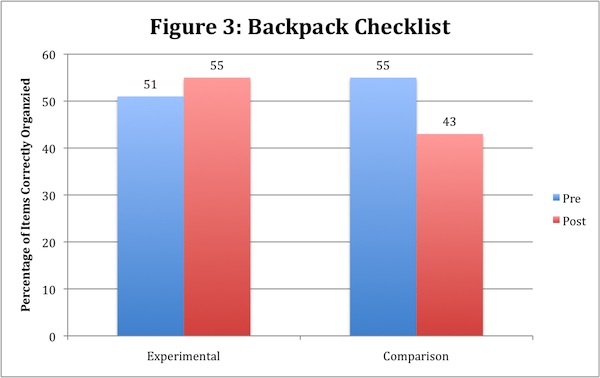
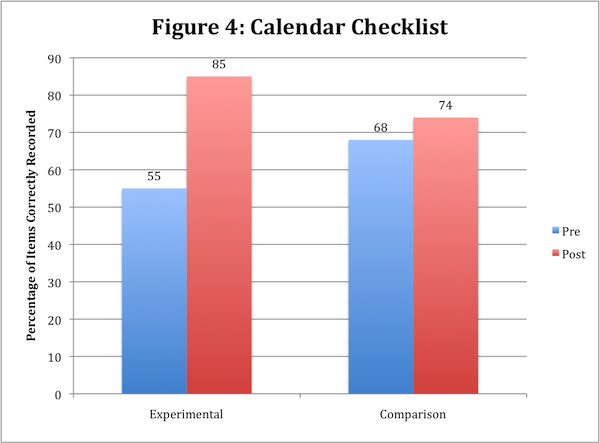
Experimental teachers and students used a 7-point Likert-type scale to rate items regarding their satisfaction with the program (“7” indicating extremely satisfied; “1” indicating extremely dissatisfied) at the end of the year. Teachers endorsed the program, and their ratings indicated satisfaction with each aspect of the program, with mean ratings on individual items ranging from 6.3 to 7.0. Their mean overall rating for the program was 6.7. Students also indicated that they were satisfied with the program, with mean scores on items ranging from 5.2 to 5.8. The students’ mean rating for the program overall was 5.5. Ninety percent of the students recommended that all third-, fourth-, and fifth-grade students receive this instruction.
Reference
Vernon, D.S. (2000). Effects of the Organizing Together program: Progress summary. Washington, D.C.: National Institute of Child Health and Human Development, SBIR Phase II #1R44HD34306.
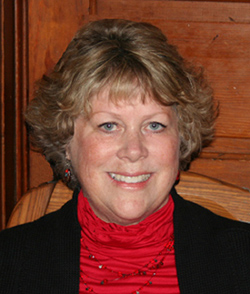
D. Sue Vernon, Ph.D.
Affliations
My Background and Interests
By wearing my different hats (a university instructor, a certified teaching-parent, a trainer and evaluator of child-care workers, a SIM professional development specialist, a parent of three children (one with exceptionalities), and a researcher), I have gained knowledge and experience from a number of perspectives. I have a history of working with at-risk youth with and without exceptionalities (e.g., students with learning disabilities, emotional disturbance, behavioral disorders) in community-based residential group-home treatment programs and in schools. I also have extensive experience with training, evaluating, and monitoring staff who work with these populations, and I have conducted research with and adapted curricula for high-poverty populations. In addition to the Organizing Together program and other programs in the Community Building Series, I’ve developed and field-tested the Cooperative Thinking Strategies Series, interactive multimedia social skills curricula, communication skills instruction, and professional development programs. I have also developed and validated social skills measurement instruments. As a lecturer of graduate-level university courses in the Department of Special Education at the University of Kansas, I have taught courses designed to enable teachers to access and become proficient in validated research-based practices.
The Story Behind the Organizing Together Program
My focus for the last 30 years has been on helping at-risk youths, particularly in the area of learning and using social skills. My interest in social skills instruction began when I was a teaching-parent in a group home for adolescents who had a history of social problems. One of our major goals in our group home was to make it a safe, respectful place where the youths would feel connected and comfortable while they were learning skills to help them succeed socially and academically. As I watched their growing success, I wanted to find a way to introduce social skills instruction to more children as a way to prevent social problems. I thought the perfect place for this instruction would be in the general education classroom.
Later, as reported school-related tragedies seemed to increase in frequency and become more deadly, I became especially interested in developing ways to prevent bullying and also in ways to create a kinder, more positive classroom environment than was commonly found in public education. A common thread in many interviews with the perpetrators of school violence was not only that they suffered from being bullied most of their lives, but they also felt no connection to their school and the people (e.g., administrators, teachers, or other students) in it.
As a result, two lines of research were born. My first series of research studies focused on social interactions in cooperative groups and resulted in the Cooperative Thinking Strategies Series. The importance of creating a positive, productive learning community in the classroom was part of each program in this series, but teachers indicated that they would like more information about creating learning communities. They wanted their students to be tolerant and supportive, and they wanted a way to systematically teach those concepts and skills to the whole class. As educators, my colleagues and I wanted to help teachers build learning communities where all student learning is supported, especially the learning of students who struggle in school. Thus, we began work on a series of instructional programs focused on the classroom community. Those programs now comprise the Community-Building Series. A founding premise associated with all the programs is that students are taught to work together and help each other.
We developed and tested the Organizing Together program in third-, fourth- and fifth-grade inclusive general education classrooms. We tested the program in those grades to ensure that young students could benefit from the instruction; however, the program has since been used successfully in secondary classrooms as well. Our goal was to develop a program that benefited students both with and without exceptionalities by helping them become connected learners within a positive, supportive learning environment. In the first lesson of the Organizing Together instruction, students review what they have learned in the Talking Together program (the first program in the Community-Building Series) including the prerequisite concepts of participating, working with partners, respect, tolerance and creating a learning community. During the next lessons in Organizing Together instruction, students learn how to organize their notebooks, desks, lockers, and backpacks. They also learn how to use a weekly calendar to record and remember assignments and events. Once instruction has been completed, students are expected to use their organizational skills throughout the school year and to help each other stay organized. Generally, the time that teachers build into the daily and weekly schedule for organizational activities results in faster transitions (e.g., while turning in papers), better grades, and happier parents.
My Thoughts About Community-Building Instruction
Observing student learning of the Organizing Together skills has been educational. The amount of “stuff” that they can fit and forget about in desks, cubbies, lockers, and backpacks is truly amazing! Organization is clearly challenging for many students. While the concepts and routines associated with organization are straightforward and easy to understand, unfortunately, many students do not use organizational skills unless they receive direct instruction. Having time structured into the class schedule and teaching students how to organize their daily lives is something the students indicate that they like, and the outcomes associated with an organized learning environment are rewarding. A colleague mentioned to me that he used the Organizing Together program in after-school sessions with middle-school students and their parents. Parents were partners in helping their child learn organizational skills and use the organization checklists. Even though the parents were almost brought to tears when they encountered homework and projects that they had spent hours helping their child complete, crumpled up and forgotten (i.e., not turned in to the teacher) in a locker or backpack, they loved the program and were excited to have new ideas and strategies to help them help their child stay organized.
Teacher and Student Feedback on the Organizing Together Program
Organizing Together has been a popular program that has been used flexibly in school, after school, and at home. Teachers at different grade levels have successfully used the program. Two comments typify the feedback that I’ve received from teachers about the program:, “The thing I liked most about the Organizing Together lessons was having all the students organize their desks in a uniform way,” and “I would definitely recommend this program to other teachers.” Examples of student comments include, “Getting organized is very helpful,” “Now I know what’s going on,” “I liked organizing my junky binder. It was cool and nice,” “I really liked knowing how to be organized,” “I like being able to find my stuff easier,” “This program is good because when you get older, you have to get organized for your jobs,” “Being organized gets you a better job,” and “Now it’s fun and easy to find things in my notebook, backpack, and desk.”
My Contact Information
Please contact me at svernon2@windstream.net

 Paragraph Writing Strategy: Student Materials
Paragraph Writing Strategy: Student Materials